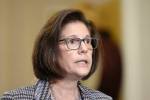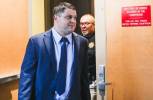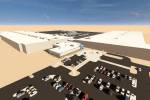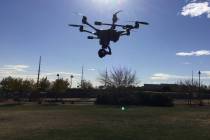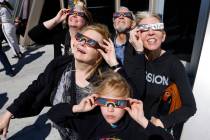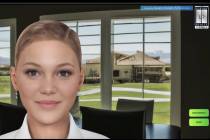Modeling Nevada’s COVID-19 outbreak, deaths no simple feat
COVID-19 could kill 800 people in Nevada by August, with the daily death toll peaking at 26 on April 18, according to a new model forecasting the spread of the new coronavirus.
Nevada’s peak use of hospital resources would occur two days later, the model predicted Friday. By then, Nevada’s hospitals would need more than 500 additional beds than they currently have and more than 200 more beds in intensive care units.
The model, created by the Institute for Health Metrics and Evaluation at the University of Washington, is one of many attempting to chart the path that the new coronavirus will take in the U.S. and in Nevada. But it has taken on prominence since being referenced a week ago by Dr. Deborah Birx, the White House’s coronavirus response coordinator.
“No state, no metro area, will be spared,” Birx said in an interview on NBC’s “Meet the Press.” “Every metro area should assume they could have an outbreak similar to New York’s,” where hospitals have been overwhelmed by a surge in cases and deaths.
Early last week, the model, which provides state-by-state forecasts, gave some reason for optimism in Nevada: The trajectory appeared to be improving, with projected total deaths dipping to just above 500 and a shortage of just 60 ICU beds.
That changed Wednesday, however, when the model shifted to project 921 COVID-19 deaths in the state and again predicted a need for about 1,000 more hospital beds than currently available.
It’s not clear what triggered the change, and staff at the institute did not respond to requests for comment. However, the model factors in emergency measures taken by officials to slow the spread of the disease and refines estimates as better data becomes available over time.
The fluctuation in predictions underscores the limitations of such models: They are only as good as their underlying assumptions, which in this instance are cloudy with so much still uncertain about the virus, including how prevalent it is in the U.S. and how deadly, and the degree to which emergency measures are helping. Put another way, the model must attempt to predict not only the behavior of the virus but the diligence with which humans follow recommended precautions to defeat it.
Bracing for the peak
It is also unclear what projections state and local governments are using as they implement new restrictions, such as Nevada Gov. Steve Sisolak’s stay-at-home directive issued Wednesday to slow the spread of the virus, which as of Friday had infected more than 1,500 and killed 43 in the state.
“Nationally there are a variety of models that can be used to potentially predict COVID-19,” said Meghin Delaney, a spokeswoman for state government’s Nevada Health Response. “The Department of Health and Human Services is reviewing all available resources, along with Nevada’s case information, in order to have the most up-to-date information to support Nevadans in our response to COVID-19.”
Delaney said that based on current estimates, Nevada will need “hundreds of thousands of N95 masks, surgical masks, gloves, and hospital gowns over the course of the next 30 days.”
As of Friday in Clark County, the location of the majority of Nevada’s cases in the state, about 29 percent of the 1,279 people testing positive required hospitalization, including those who later died, according to data from the Southern Nevada Health District’s website.
“The Southern Nevada Health District is working with our local, state and federal partners to be prepared to address hospital overflow and obtain resources,” spokeswoman Jennifer Sizemore said. “We are working to put these resources in place as quickly as possible.”
Both Delaney and Sizemore declined to provide estimates for when the disease might peak or for the total number of deaths expected.
But the Las Vegas Valley’s largest hospitals say they are preparing for local COVID-19 cases in Nevada to peak as soon as mid-April.
These include University Medical Center, Valley Health System’s six local hospitals and HCA Healthcare, parent company of four local acute-care hospitals, according to spokespersons.
UMC is also analyzing “multiple predictive models from trusted sources,” spokesman Scott Kerbs said. He did not provide specifics on the models being used by the hospital.
Modeling flaws
The Institute for Health Metrics and Evaluation’s model on Friday predicted nearly 94,000 deaths from COVID-19 nationwide by early August, more than 12,400 above what it was projecting a week ago.
Still, the estimate was toward the lower end of the spectrum for modeling of the disease’s impact.
Birx said Tuesday at a White House briefing that deaths in the U.S. could number between 100,000 and 240,000, even with emergency measures in place.
Some models have forecast the U.S. death toll to exceed 2 million — a possibility, White House officials have said, if the U.S. fails to follow aggressive measures to slow the spread.
But the problem with predictive models is that “they are only as good as their assumptions and parameters, and right now, these are all unknown,” said Brian Labus, an assistant professor of epidemiology at UNLV’s School of Public Health.
The variables for which there are only estimates include how prevalent the virus is in the U.S. population, how readily the virus spreads from person to person and what the actual death rate will be. Further complicating matters is factoring into the calculations the impact of various emergency measures, such as social distancing and closing schools and businesses.
“I think the models are good at saying that one particular course of action is better than another, but they are not good at predicting the course of this outbreak,” said Labus, who serves on the governor’s medical advisory team for COVID-19.
Far more dire than the institute’s forecast, a model published by COVID Act Now estimated as recently as Wednesday that the disease kill could kill 47,000 people in Nevada, even with social distancing in place for three months. The organization, headed by a software engineer for Google, saw hospitals in the state becoming overwhelmed in mid-April.
The model predicted even more deaths — 62,000 — without social distancing and just 2,000 deaths if sheltering in place were strictly observed for three months.
Possible toll lowered
However on Friday, after the governor’s stay-at-home directive, the model forecast far fewer fatalities: 14,000 deaths if compliance is poor, and 4,000 deaths with strict compliance. With poor compliance, hospitals could become overwhelmed by May 12, and hospitalizations peak at nearly 17,000 on June 19. It cautioned that there could be another spike in illness when social distancing measures stop.
Labus said that the COVID Act Now’s most dire forecasting assumed that 70 percent of people would become infected and a death rate of 3 percent, both of which are at the high end of estimates. It also makes assumptions in terms of the degree to which social distancing will help matters — “another thing I don’t think we can agree on,” he said.
Another fault of modeling is that it typically treats Nevada as a single entity despite differences among urban, suburban and rural areas. Labus said, noting that infection rates and health care delivery will vary from community to community.
What many of the models have in common is that they project a three-month cycle for the disease, Labus said, and that “it’s going to get worse before it gets better.”
The models all raise the specter of not enough hospital beds, especially in intensive care units. But Labus said that’s just one piece of the puzzle.
“What’s going to happen if we have more patients than we have supplies to take care of them?” Labus asked rhetorically, referring to protective gear for medical personnel, ventilators for patients and other essential equipment. “Thinking that that’s something potentially we’re going to have to deal with is really terrifying.”
Contact Mary Hynes at mhynes@reviewjournal.com or 702-383-0336. Follow @MaryHynes1 on Twitter. Contact Michael Scott Davidson at sdavidson@reviewjournal.com or 702-477-3861. Follow @davidsonlvrj on Twitter.









